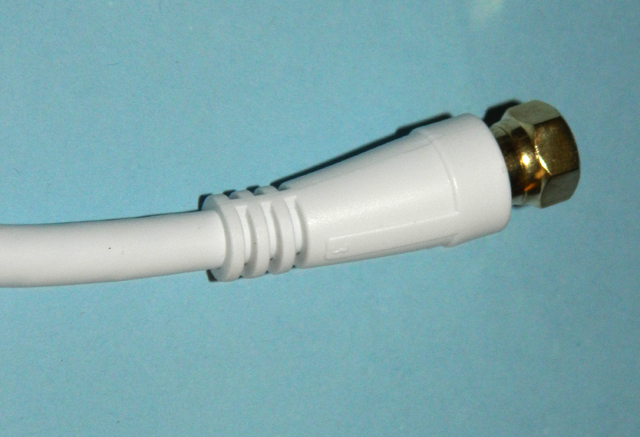You hear us saying it over and over again: If you’re hooking up cable or satellite, stay away from cables with molded ends. If an installer comes and sees you using them, he’ll replace them on the spot. When people come to our live chat or call us on the phone with problems, that’s one of the first things we’ll suggest replacing. If someone sends us a picture of a cable and it looks like the one you see above, we always tell them it’s no good.
Why all the hatred?
So why all the hatred for these cables? Could molded plastic really make that much of a difference? Yes and no… when you see cables with molded ends, you know they’re not designed to be used for high-bandwidth applications like cable and satellite. They may work for a little while, but eventually they’ll disappoint you. Often times it’s not even the molded end that will let you down… that’s just the easiest way to tell an inferior cable. Here are some reasons to avoid those pre-made cables from home stores:
The molded ends do actually give less shielding.
A proper compression connector is waterproof and provides a little extra shielding from stray RF signals. A molded end could crack and let water in, and that plastic isn’t going to help with interference.
People say, “if the whole thing is one piece of molded plastic, how could that be worse than a compression fitting?” The issue is the way it’s made. If I could be confident that the connector were made to the highest standards, I’d say yes the molded one would be better. But, connectors with molded ends usually have very weak metal on them and there’s not enough shielding provided for the outer braid of the cable.
In order to use satellite TV, you need really good cable.
Unlike antenna TV, the cables used for satellite carry a signal all the way up to 2150MHz frequencies, Not every cable is designed to give a clean transmission at those frequencies, and there are no satellite-approved cables with molded ends, so any cable with molded ends isn’t certified to work with satellite TV. Most cheap cables are only tested to about 1000MHz meaning that you just don’t know how they’ll perform at higher frequencies. It’s worth pointing out that pretty much all the signal that’s coming down from a satellite dish is at frequencies higher than 1000MHz.
They probably have more loss than satellite-approved cables.
Most cables you get at home stores conform to the RG59 standard for how much shielding they have and the size of the dielectric foam inside them. That means you won’t be able to go as far without reception problems. Even if they say they conform to the RG6 standard, they probably don’t. Truth is there’s really no enforcement of those standards.
For satellite, you need a solid copper center conductor.
In order to use satellite TV or even to use an antenna amplifier, you need a solid copper center conductor. Only solid copper can carry the voltage needed for these systems. Most inexpensive cables use copper-clad steel for the center conductor. Even if that seems to work for a short time, you’ll soon be disappointed. It won’t work for long. Even the tiniest scratch in the center conductor can stop the flow of power.
At the end of the day, getting the right cable from Solid Signal isn’t a lot more expensive and it’s a sure way to make sure you’re getting the quality that you need.
Still not sure what cable is best? Do you have other questions? Are you looking at upgrading? There’s an easy way to get all your questions answered. Solid Signal isn’t your normal online retailer. We have a full staff of techs in our Detroit-area offices. We don’t use overseas call centers. Our folks don’t read from scripts. We specialize on giving excellent customer service.
Find out more about the Solid Signal difference. Call us at 888-233-7563 during East Coast business hours. Or, use the chat button at the lower right of this page. If it’s after hours, fill out the form below. We’ll get right back to you!





